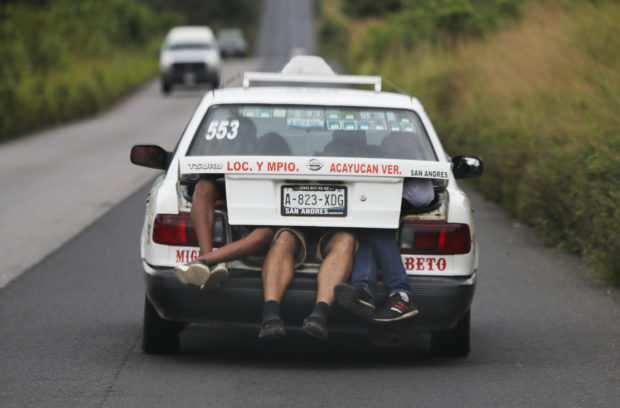Migrant caravan in Mexico trudges through ‘route of death’

Central American migrants, part of the caravan hoping to reach the U.S. border, a ride on in the trunk of a taxi, in Acayucan, Veracruz state, Mexico, Saturday, Nov. 3, 2018. (AP Photo / Marco Ugarte)
ISLA, Mexico — Hundreds of Central American migrants from a 4,000-strong caravan winding its way through southern Mexico and toward the U.S. border splintered off on their own Saturday after broken promises of bus transportation.
Patience appeared to be wearing thin among the exhausted trekkers after Veracruz Gov. Miguel Angel Yunes reneged on an offer Friday to provide buses to leapfrog the migrants to the Mexican capital. Tempers flared as the migrants struggled with exhaustion, blisters, sickness and swollen feet.
Caravan organizers have pleaded for buses in recent days after three weeks on the road, hitching rides and walking. The group scattered between several towns in Veracruz Saturday, raising questions of whether they would stick together.
Several thousand planned to spend the night in Isla, about 700 miles (1,126 kilometers) south of the U.S. border, while another large contingent hunkered down in Juan Rodriguez Clara and yet another reached Tierra Blanca, 80 miles (129 kilometers) to the north.
In a statement, the migrants lambasted Mexican officials for directing them northward through the Gulf Coast state of Veracruz, calling it the “route of death.” Some migrants branched off in the belief that they were near the metropolises of Puebla and Mexico City, where they aimed to rest and receive medical attention.
Article continues after this advertisementA trek via the sugar fields and fruit groves of Veracruz takes them through a state where hundreds of migrants have disappeared in recent years, falling prey to kidnappers looking for ransom payments.
Article continues after this advertisementAuthorities in Veracruz said in September they had discovered remains from at least 174 people buried in clandestine graves. Some security experts have questioned whether those bodies belonged to migrants.
Ibis Villanueva, 32, said he decided to strike out on his own for Puebla because he felt frustrated by the lack of organization in the caravan.
“We don’t believe the coordinators anymore. Yesterday they said we were going on bus, today no,” said the sunburned welder from Honduras.
Gerardo Perez, a 20-year-old migrant, said he was tired. “They’re playing with our dignity. If you could have only seen the people’s happiness last night when they told us that we were going by bus and today we’re not,” he said.
The caravan’s ‘strength in numbers’ strategy has enabled them to mobilize support as they move through Mexico and has inspired subsequent migrants to try their luck via caravan.
Mexico now faces the unprecedented situation of having three caravans stretched over 300 miles (500 kilometers) of highway in the states of Chiapas, Oaxaca and Veracruz, with a total of more than 6,000 migrants.
On Friday, a caravan from El Salvador waded over the Suchiate River into Mexico, bringing 1,000 to 1,500 people who want to reach the U.S. border.
That caravan initially tried to cross the bridge between Guatemala and Mexico, but Mexican authorities told them they would have to show passports and visas and enter in groups of 50 for processing.
Another caravan, also of about 1,000 to 1,500 people, entered Mexico earlier this week and is now in Chiapas. That group includes Hondurans, Salvadorans and some Guatemalans.
The first, largest group of mainly Honduran migrants entered Mexico on Oct. 19. At its peak that caravan swelled to an estimated 7,000 participants.
Mexican officials appear conflicted over whether to help or hinder their journeys.
Immigration agents and police have at times detained migrants in the smaller caravans. There has also been pressure on the main caravan, with federal police pulling over freight trucks and forcing migrants off, saying that clinging to the tops or sides of the trucks was dangerous.
But several mayors have rolled out the welcome mat for migrants who reached their towns – arranging for food and camp sites. Mexico’s Interior Department says nearly 3,000 of the migrants in the first caravan have applied for refuge in Mexico and hundreds more have returned home.
With or without the government’s help, uncertainty awaits.
President Donald Trump has ordered U.S. troops to the Mexican border in response to the caravans. More than 7,000 active duty troops have been told to deploy to Texas, Arizona and California ahead of the midterm elections.
He plans to sign an order next week that could lead to the large-scale detention of migrants crossing the southern border and bar anyone caught crossing illegally from claiming asylum.